SCIENTIFIC NAME:
Anas bahamensis
OTHER NAMES:
Bahama Duck
STATUS:
Accidental.
DESCRIPTION:
White-cheeked Pintails are large dabbling ducks. Adults are similar in appearance to a female Northern Pintail. Males are light brown, heavily spotted with a brown crown and nape, a white cheek patch that extends down the throat, and a blue-grey bill with a bright red spot at its base. They have a green speculum on their wing and pointed tails that are yellow in appearance. Their legs and webbed feet are dark grey. Females are similar to males but paler.
DISTRIBUTION:
White-cheeked Pintails are found on the islands of the Caribbean (West Indies), mainland South America and the Galapagos Islands. They have been found from sea level to 2,500 meters of elevation in Bolivia. They are occasionally found in the brackish waters along the Gulf Coast in the states of Florida and Texas.
HABITAT:
White-cheeked Pintails can be found near rivers, lakes and ponds. They also will occur in coastal marshes and rocky or sandy seashores.
FEEDING HABITS:
The White-cheeked Pintail is a dabbling duck. They can dive while feeding, but they prefer to up-end their bodies putting their heads under the water keeping their feet and tails above water. They feed on aquatic animals, aquatic vegetation and algae.
LIFE HISTORY AND ECOLOGY:
Female White-cheeked Pintails mate with only a single male during the breeding season. Males however will attempt to breed with other females if they are close by. If a female has already mated, she will resist these advances. During the breeding season females will build nests of leaves that they hide in grassy areas along mudflats, marshes or mangrove swamps. Clutches average from five to 12 cream or buff colored eggs. Incubation lasts approximately 24 to 25 days.
White-cheeked Pintails are relatively silent for a duck. The male’s call is a low whistle while the female’s call is a weak quacking sound. Also, these ducks are non-migratory.
REFERENCES:
Whatbird.com
http://identify.whatbird.com/obj/1029/behavior/White-cheeked_Pintail.aspx
http://www.foundalis.com/bio/zoo/bahamens.htm
Animal Corner
http://www.animalcorner.co.uk/galapagos/whitechkpintailduck.html
Mangrove World Bird Guide
http://www.mangoverde.com/birdsound/spec/spec27-103.html
Author:
Mitchell Marks, Wildlife Biologist, Division of Wildlife and Freshwater Fisheries






